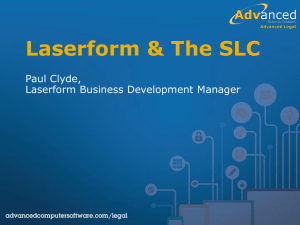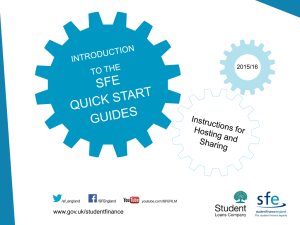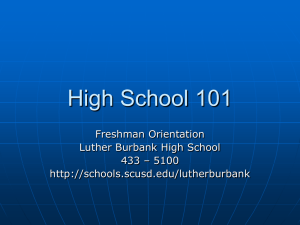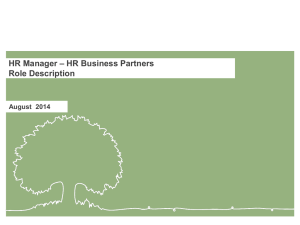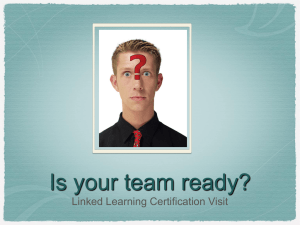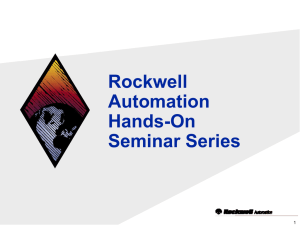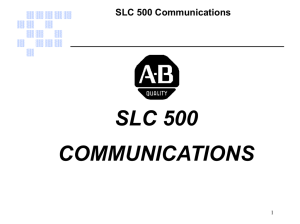Long Beach Linked Learning Initiative Presentation (US
advertisement
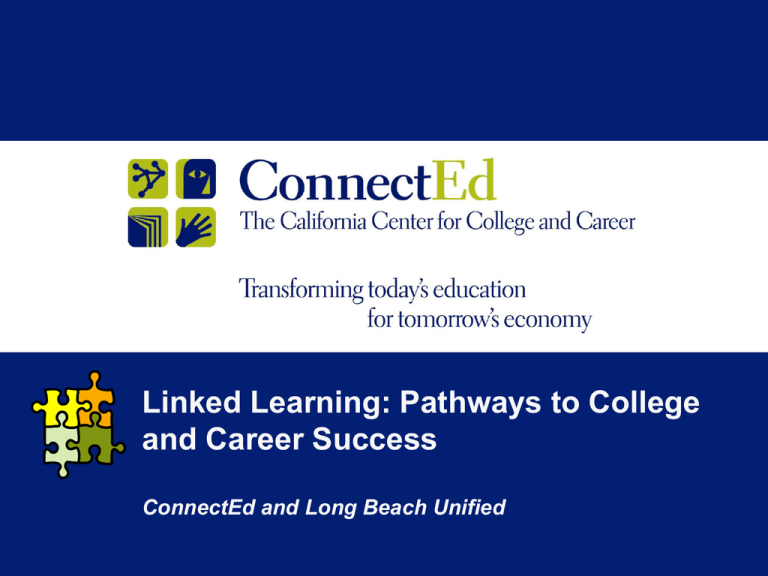
Linked Learning: Pathways to College and Career Success ConnectEd and Long Beach Unified The State of Education… “The best employers the world over will be looking for the most competent, most creative, and most innovative people on the face of the earth and will be willing to pay them top dollar for their services… Beyond [strong skills in English, mathematics, technology, and science], candidates will have to be comfortable with ideas and abstractions, good at both analysis and synthesis, creative and innovative, selfdisciplined and well organized, able to learn very quickly and work well as a member of a team and have flexibility to adapt quickly to frequent changes in the labor market as the shifts in the economy become even faster and more dramatic.” The New Commission on the Skills of the American Workforce, 2007 The State of Education… So how do we fare academically on the international landscape compared to other countries in the Organization for Economic Cooperation and Development (OECD)? Program for International Student Assessment (PISA) US ranks : 14th in Reading 25th in Math 17th in Science But this is only one measure… “…. So, the big picture from PISA is one of education stagnation at a time of fast-rising demand for highly-educated workers. The mediocre performance of America’s students is a problem we cannot afford to accept and cannot afford to ignore.” Secretary Arne Duncan December 7, 2010 State of the Economy and Education (National Trends) Source: Bureau of Labor Statistics “So What Now?” Consensogram Activity 1. To what degree are you familiar with the Rigor and Relevance Framework? 2. To what degree does my SLC integrate real-world applications into the academic core? 3. To what degree does my SLC team know what our local workforce requires of a graduating senior? 4. To what degree does your SLC team use problem- and/or project-based learning to drive the curriculum? 5. To what degree do you believe that ALL students can be college and career ready upon graduation from your SLC? Let me tell you a story... What is Linked Learning? The Linked Learning approach offers students a choice among several different multi-year programs of study, which combine academic and technical skills, organized around broad industry themes (i.e., biomedical science; engineering; arts, media, entertainment) and prepare students for a full range of postsecondary options, including: – 2- and 4- year college/university admission – Apprenticeships – Military – Formal employment training – Careers Organizing Principles • Prepare students for both college and career • Connect academics to real-world applications • Lead to the full range of postsecondary options • Improve student achievement Pathway Components • • • • A Challenging Academic Component A Demanding Technical Component A Work-based Learning Component Support Services Math Science English Social Studies Technical Core/Work-based Learning Prepared for College and Careers Post-Secondary Articulation College and Career Plan----------college Tours----------Applications ------------Courses Middle School Articulation Social Studies Social Studies Social Studies Social Studies Math Math Math Math Technical Core Introductory Level Technical Core Intermediate Level Technical Core Capstone Level Technical Core English English English English Science Science Science Science Support Services Support Services Support Services Support Services Work-based Learning Opportunities Company Tours ----------------------------Job Shadowing------------------------------ Internships Multiple PostSecondary Opportunities Reflection: Linked Learning • How does your SLC reflect these guiding principles? • How does your SLC integrate the four core components? Example • Health Professions High School in Sacramento Pathways… Bring real world relevance to the college preparatory curriculum. Promote project-based teaching and learning. Use more authentic assessment methods. Alignment: Foundations for Engaging Every Learner, Every Day Instructional practices that support the ACSI, HSRI, and HSO Goals: High School Reform Initiative 2009-2014 1. Implement a rigorous and relevant multidisciplinary curriculum in the academic core to increase student achievement. 2. Provide all students with a sequenced and aligned technical curriculum, including work-based learning and CTE experiences, for career exploration. 3. Provide for consistent and sustained support, including prevention and intervention, to ensure that all students achieve their maximum potential. Classroom Instructional Practices Department/SLC PD Evolution/Action Plans Site-Level School Improvement Plan (WASC) • RR Framework (Quadrant D) • Linked Learning Strategies • Performance Mapping: Interdisciplinary Teaching & Learning High School Office Goals 2010 – 2011 Prepare all students for postsecondary education & careers through linked learning. Provide support services within each pathway. Enroll and support students in a coherent sequence of rigorous courses aligned to student outcomes. High School Office 4. Create a holistic campus climate where relationships, social behavior, and positive professional interactions lead to academic success. High School Reform Initiative/District Initiative for Expanding Pathways LBUSD Board of Education/Superintendent’s Office Academic and Career Success Initiative Taxonomy Quadrant D ⎯ Adaptation Evaluation 6 Synthesis 5 Analysis 4 Application 3 Comprehension 2 Knowledge/ Awareness 1 Rigor Relevance Framework 2008 International Center for Leadership in Education Students have the competence to Quadrant C ⎯ Assimilation think in complex ways and also Students extend and refine their apply knowledge and skills they acquired knowledge to be able have acquired. Even when to use that knowledge confronted with perplexing automatically and routinely to unknowns, students are able to use extensive knowledge and skill to analyze and solve problems and create solutions and take action that create unique solutions. C A D B further develops their skills and knowledge. Quadrant B ⎯ Application Students use acquired knowledge to solve problems, design solutions, and complete work. The highest level of application is to apply appropriate knowledge to new and unpredictable situations. Quadrant A ⎯ Acquisition Students gather and store bits of knowledge and information. Students are primarily expected to remember or understand this acquired knowledge. 1 2 3 4 5 Knowledge in one discipline Apply in discipline Apply across disciplines Apply to realworld predictable situations Apply to real-world unpredictable situations Application Model • SLC structures and themes give us a context for the “Application” axis on the Rigor and Relevance Framework. – i.e., business academy students can learn the historical context of To Kill A Mockingbird by studying the Stock Market Crash, while arts academy students can accomplish the same task by analyzing Billy Holiday’s Strange Fruit and pictures of the “Dust Bowl” Past: Student Experience was not coordinated for student engagement or real-world connections. But how can we organize our work between the disciplines to ensure a coherent experience for the students? Linked Learning: Student Experience IS now coordinated for student engagement and real-world connections. Industry Sectors and Organizing Themes Why Themes? • Context and purpose • Provides relevance and connections for the students • Provides a common ground for content specific teachers to talk and plan • Connection for business/community Determining Themes: Factors to Consider • • • • • • • • Successful programs Student interest Labor market demands Community resources College connections Partnerships Facilities Staff interest From Student Learning Outcomes to Student Outcome Charts • Opportunity for expert practitioners to work in interdisciplinary communities to define what students should know and be able to do within a particular themed course of study. • Process that empowers a pathway to define its own identity around key industry themes. Why Define Student Learning Outcomes? • “Clarity of desired ‘end’ provides the framework for designing ALL student experiences.” • Ensures a rigorous and RELEVANT experience for all students within a pathway. Student Outcome Charts Student Outcome charts are a tool that provides a blueprint for a coherent, engaging four year educational experience above and beyond the academic standards all students take. Alignment to an Industry Sector and then a subsequent Pathway is critical to focusing our work and making sure that students have a coherent educational experience. Recognize that certain sectors (& even pathways) may NATURALLY overlap: – Engineering & Construction – Arts, Media, Entertainment & Fashion/Interior Design – Finance/Business & Marketing, Sales, Services – Etc. PEACE Academy • Industry Sector: • Pathway: Public Services Legal/Government Services Process VISION More broad and future oriented… “what” we hope to be about. MISSION More specific and defines “why/how” we will get there. GOALS AND OUTCOMES Why this common language is so important… • Finish each of the following proverbs/aphorisms… – – – – – – – People in glass houses shouldn’t… You can lead a horse to water, but… Don’t bite the hand that… You can’t teach an old dog… A penny saved is… None as so blind as… When the blind lead the blind… PEACE Academy • Vision: “Enter to Learn, Exit to Serve” • Mission: “The PEACE Academy is an international negotiations and leadership academy that promotes critical thinking, community-minded students to advocate for social justice through philosophical debates, service learning projects, international negotiations, and complex instruction.” Student Outcomes…. focus on those skills and abilities most critical to success within your career theme. So where do these come from? Foundation Standards They cover the 11 areas essential to all students’ success: • • • • • • • • • • • 1.0 Academics 2.0 Communications 3.0 Career Planning and Management 4.0 Technology 5.0 Problem Solving and Critical Thinking 6.0 Health and Safety 7.0 Responsibility and Flexibility 8.0 Ethics and Legal Responsibilities 9.0 Leadership and Teamwork 10.0 Technical Knowledge and Skills 11.0 Demonstration and Application Framework – pages xvi - xvii Pathway Standards • The pathway standards are concise statements that reflect the essential knowledge and skills students are expected to master to be successful in the career pathway. • Each career pathway comprises 3 to 12 standards with 2 to 6 subcomponents per standard. Framework – pages xvi - xvii Define Attributes of Students in this Pathway… Strategy: – Take the Pathway Standards assigned. – Informally unpack the standards to see: • What students should be able to do? VERB - circle – Consider the level of rigor (Bloom’s Taxonomy) – Skills that students might need to master to meet/exceed the standard • What content do students need to know? NOUN - underline – Discuss themes & patterns that emerge from this process and use those to define your students’ 3-5 attributes (adjective to describe a student in this pathway). Attributes can also be known as the broad pathway outcomes. Student Outcomes (Deep Dive)… Are observable, measurable results or evidence of the educational experience. They may be things the program wants: – students to know (cognitive), – ways students think (affective/ attitudinal), or – things students should be able to do (behavioral, performance, psychomotor). They are detailed & meaningful enough to guide decisions in program planning & improvement, & decisions about From CUPR Common Language doc pedagogy & practice. NOT ACTIVITIES. Course (Program) of Study Integrated Curriculum and Linked Learning: Performance Mapping Integrated Curriculum Institute This professional development is • Process driven: Performance Mapping • Product driven: Integrated Project Integrated Curriculum Institute The goal of performance mapping is to use content area standards and pacing guides to discover crosssubject area connections from which to build an authentic integrated project. 47 Integration Continuum Math ELA CTE Theme-based Real-World Application SCI ARTS SOC Single Subject BASIC Paired Interrelated INTERMEDIATE For Lang Conceptual COMPLEX 48 Integrated Curriculum Design 1. Student Outcomes 2. Curriculum/Performance Mapping 3. Share Curriculum and Find Connections 4. Topic Selection 5. Essential Question 6. Establish Performance Tasks/Assessments 7. Lesson Plans 8. Reflection and Revision Industry and post-secondary partners advise in: •Curriculum Development •Instruction and Implementation •Student Assessment Unpacking the standards Uncover to determine: • Standard Identification: • Content: what students know… • Skills: what students are able to… (performances) • Performance Standard Measures and Criteria: • How students demonstrate mastery of knowledge and skill Unpacking the Standards Active Verbs matter! Verbs establish the level of learning and drive the assessment methods Performance measures and activities in the project must allow students to do the VERB! 51 Place your post-it notes in chronological order on the butcher paper Take turns explaining the details of your content to the team. Connections across subjects come from both verbs (skills = what students should be able to do) AND/OR nouns (content = what students should know) 54 Make Connections Your Turn • Practice making connections with a partner • Share and discuss your findings at your table Performance Map Template Across Subject Areas Subject Monday Science English Identify various modes of transmission for common pathogens Find information on the topic using a minimum of five sources Tuesday Wednesday Demonstrate proper experimental procedure Draw conclusions from data regarding prevalence of bacterial contamination Evaluate the credibility and reliability of resources. Distinguish between active and passive transport along concentration gradients. Thursday Friday Explain how different factors influence the spread of disease Analyze and evaluate symptoms to determine patient health status Paraphrase the research into your own words. Formulate a preliminary thesis statement to reveal the specific point of the paper. Analyze structural differences between cells and viruses Prepare a formal outline using proper outlining form. Compare and contrast viral replication and cellular division 57 Topic Selection • Reflects focus of your SLC • Relevant to students’ lives and interests • Includes student investigation and research • Addressed through multi-disciplinary perspectives • Includes industry & college professionals 58 Integrated Planning in Action Video: San Diego Teachers 59 Four Major Characteristics of Integrated Projects 1. Standards driven – timely and identifies level of mastery 2. Inquiry driven – becomes the students’ problem 3. Authentic – product, performance, service or solution 4. Personalized – differentiated based on students’ motivation and skills 60 Let’s Take a Closer Look Integrated Project Quality Criteria Project Title: Forensic Investigation Integrated Curriculum Design 1. 2. 3. 4. 5. Student Outcomes Industry and post-secondary Curriculum/Performance Mapping partners advise in: Share Curriculum and Find Connections •Curriculum Topic Selection Development Essential Question 6. Establish Performance Tasks/Assessments 7. Lesson Plans 8. Reflection and Revision •Instruction and Implementation •Student Assessment • Video Example Integrated Curriculum Design 1. 2. 3. 4. 5. 6. Student Outcomes Industry and Curriculum/Performance Mapping post-secondary Share Curriculum and Find Connections partners advise in: Topic Selection •Curriculum Essential Question Development Establish Performance Tasks/Assessments 7. Lesson Plans 8. Reflection and Revision •Instruction and Implementation •Student Assessment Integrated Problem-Based Projects Topic Essential Question SLC: Industry Sector World Hunger: Heifer International How can I impact the world by thinking globally and acting locally? PEACE 10th grade: Public Services Environmental Issues: Long Beach Breakwater Can we change our environment? PEACE 9th grade: Public Services Port of Long Beach How do efficiency and innovation affect ethics? CAMS 10th grade: Engineering Technology Improving Community Health How can you make your community healthier with $1 million? CAMS 9th grade: Biotechnology/Health Water Conservation: Design a “Blue” house How can we develop a system that will deliver sustainable, clean water? ACE 10th grade: Architecture, Construction, and Engineering ConnectEd Resources • Tools and manuals • Video examples • Self Assessment Rubrics • Certification Criteria • Online collaboration spaces • District framework for support What I didn’t tell you was... • • • • • • High academic rigor Technical core was college level There was an internship connected The theme was integrated in all courses Multidisciplinary Exhibition of the work was primary • Who was the student? Team Debrief: Force Field Diagram SAMPLE: All teachers use performance mapping to integrate academic content with relevant real-world competencies resulting in students who are college and career ready [SLC Cohort 10 Goal 1 &3]. DRIVERS • Funding available for training. • Teachers will be comforted by the fact that they do not have to abandon standards and pacing guides. • Student-focused, teacherfriendly approach that respects a teacher’s expertise PREVENTERS • Master schedule will have to support collaboration between grade-level teams within the school day. • Getting our Curriculum Office in the district to support this work. • Going to scale seems daunting. • People may not know how to collaborate. Action Steps: • Schedule a meeting with the Assistant Superintendent of Curriculum and Instruction to introduce this approach. • Create a needs assessment to make sure the professional development is needs-driven and presumptive. • Pilot the training with one SLC to determine how to tailor the approach to our district. Contact Information • Rob Atterbury, ratterbury@connectedcalifornia.org Director of Professional Development, ConnectEd: The California Center for College and Careers • Nader Twal, ntwal@lbschools.net SLC Project Director, Long Beach Unified • Veronica Evans, vevans@lbschools.net Academic and Career Tech Ed Curriculum Leader, Long Beach Unified Why reforms fail? • Lack of real commitment, buy-in, and a confluence of effort • No outside force balancing the changes in leadership and their whims • Lack of fidelity to the model, cutting corners • Lack of a systemic approach • Involvement of everyone in the design and development • Change the structure and never change the instruction or culture The Evidence • Compared with their peers, students in pathways: o Attend at higher rates o Are less likely to drop out and more likely to complete high school o Pass the California High School Exit Exam at higher rates o Are more likely to score proficient or higher on California Standardized Tests in English, science, and social studies o Earn more annually in the five years after high school graduation – $2,500 per year more!
